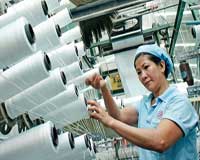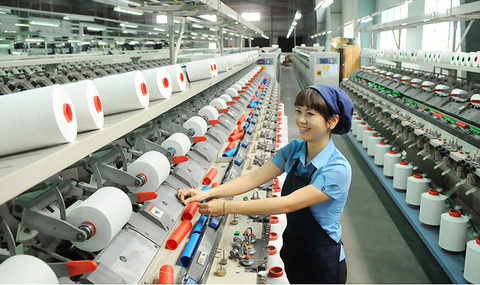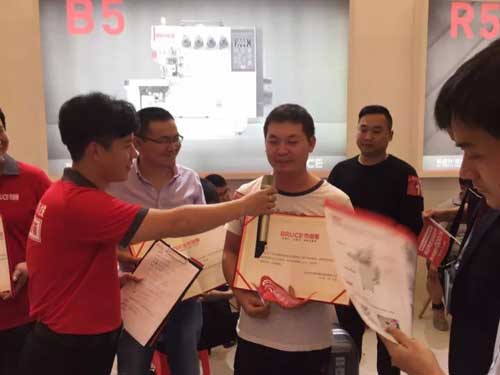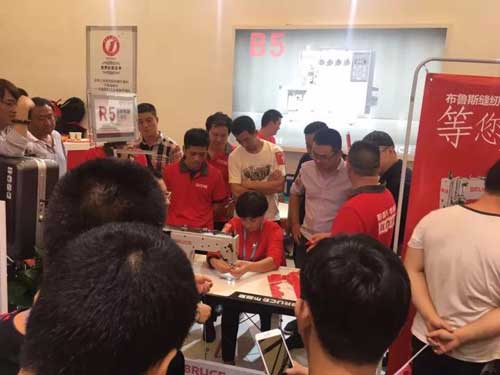FW
Egypt’s textile exports increased by about 12 per cent this year while imports declined by 59 per cent. A national strategy is being prepared for the textiles, spinning, and readymade clothing industry aimed at promoting the textile industries sector in Egypt in all stages of production from cotton cultivation until accessing the final product.
A new textile city will be established. The industry will be upgraded to meet the needs of the local market and to promote Egyptian readymade clothes to global markets. The country is exerting efforts to curb smuggling operations, which negatively impact the textile industry. Measures will be taken to eliminate these illegal practices.
Effective initiatives will be adopted to increase investment and export rates within the textile sector. Egyptian long staple cotton is famously used for luxury linens. It trades at a high premium compared to the more common short-staple cotton.
In the past two years, Egypt has taken measures to restore seed purity and cotton quality. Egyptian cotton’s length, strength, firmness, color, trash count and maturity have all improved in 2016-2017 compared to 2015-2016. This development has increased the demand and the prices for Egyptian cotton in local and international markets.
Jesse Daystar is new vice president and chief sustainability officer of Cotton Incorporated. Before joining Cotton Incorporated, he was director at the Duke Center for Sustainability and Commerce at Duke University, where he also taught. He earned a doctorate in forest biomaterials from North Carolina State University.
His experience includes sustainable chemical process development and efficiency management program development with the National Council for Air and Stream Improvement.
Daystar is well-versed in the complexities of sustainability research, particularly as it relates to cellulosic fibers, including cotton. His research has appeared in scholarly journals and his consulting work has led to the development of sustainability and chemical engineering tools and certifications for clients including the United States Department of Agriculture, Department of Energy, Eastman Chemical, and Piedmont Biofuels.
Cotton Incorporated is the research and promotion company of US cotton producers and importers. Cotton Incorporated, funded by US cotton producers and importers of cotton and cotton textile products, conducts worldwide research and promotion activities to increase demand for and profitability of cotton. It has a commitment to sustainability of cotton across the supply chain.
Daystar brings a wealth of experience and knowledge to this newly created role, which will oversee and coordinate Cotton Incorporated’s internal and external sustainability efforts.
People want denim with color. There’s more trend towards colors, less towards indigo. Diehard denim buyers won’t be looking away from the trusty blues but those that follow fashion will likely be keener on color for the coming season.
Corduroys and velvet will start to introduce color into more bottom weights, which will then lead to greater uptake in twills. Corduroys in the coming season will come with colorful tie-dye effects—which many customers have expressed interest in—or in pinks or coral colors with detailing at the cuff.
Hong Kong-based Prosperity Textile, which does garment and piece dyes for its Feel It collection of denim with Tencel branded lyocell fibers, has pink and olive colors in the line. Tencel holds color well. Thailand-based AMC has been aggressive on color for some time. AMC does double dye denim, where the fabric gets dyed khaki and then a color pigment coating is added to the face. When washed there is color loss and distressing reveals the original color of the jean—and buyers are keen on the coloring.
The denim area of Premiere Vision Paris showed colors from coral to pink, olive and tie-dye. Japan’s Toray has an indigo velvet blazer with cotton. The indigo gives the jacket an authentic denim look. Since customers like soft fabrics, Toray uses Lenzing modal and Tencel for most of its collection.
CISMA has been going on for four days with a flood of people, Many booths are bustling. Bruce booth is one of them.
CISMA launched on September 26th this year, and the birth time of Bruce's new computerized lockstitch sewing machine R5 was just in time to catch the last express train for CISMA .
On September 14th, Bruce R5 sewing machine hit the world’s longest recordof the continuous empty step without any break of thread. Its superior performance attracts the attention of the section world——if you are afraid of skipping, afraid of break, pls choose Bruce.
The section world was boiling with this exciting message that the machine will be presented in CISMA.
Bruce’s booth is located in hall W1, booth no.1,nearest to the entrance. The crimson tone, coupled with Bruce's dazzling display, attracte the attention of the visitors at once.In the exhibition site, Bruce launched the "Bruce sewing world record challenge", so that visitors can personally experience the stability and operational comfort of R5 ,even challenge the world record—— Bruce’s computerized lockstitch sewing machine being no thread break for 64.8 meters by continuous empty steps.In just a few minutes, the number of applicants exceeded the rules of the competition.When competition ended, although no one can break the Bruce’s 64.8 meter world record, nevertheless, the result also makes people pleased and satisfied. A number of Challenger scores reached more than 40 meters, and the top record is 46.64 meters, quite closely to the world record.
Bruce Industrial Sewing Machinery Company was founded in 2006, the company is located in Taizhou City, Zhejiang Province. China. which is the world’s most important production and R & D base of sewing machines.With introduction of most advanced technology and equipments, the company has nearly 100 high precision machining centers and tens of millions of investment of testing equipment, fully guarantee the stability and reliability of products. It is the domestic leading sewing machine manufacturer, productssale are among the top within country, with saling network covering more than 30 domestic provinces, cities and autonomous regions, the company’s business also enter more than 100 countries and regions of the world.
"Vietnam has slowly and steadily gained major ground in world’s biggest apparel market – the US -- with its high quality textile offerings. As Vu Duc Giang, Chairman, Vietnam Textile and Apparel Association (VITAS) points out Vietnam's textile and garment export turnover, in 2017, is estimated at $30.5 billion, of which the US market accounts for approximately 51 per cent of total turnover. In the first eight months of 2017, textiles and garments exports grew steadily, with export value increasing by 9.9 per cent, over the same period last year, to $19.8 billion."

Vietnam has slowly and steadily gained major ground in world’s biggest apparel market – the US -- with its high quality textile offerings. As Vu Duc Giang, Chairman, Vietnam Textile and Apparel Association (VITAS) points out Vietnam's textile and garment export turnover, in 2017, is estimated at $30.5 billion, of which the US market accounts for approximately 51 per cent of total turnover. In the first eight months of 2017, textiles and garments exports grew steadily, with export value increasing by 9.9 per cent, over the same period last year, to $19.8 billion. Currently, textile and garment exports to the US account for the largest share of the industry, making up around 51 per cent of the export market share.

Meanwhile, Vietnam is also importing cotton from the US for its spinning industry, accounting for up to 60 per cent of its total demand. In recent years, cotton cultivation area in Vietnam have narrowed down to just 0.04 per cent of the total demand. Meanwhile, American cotton is considered the best for Vietnamese spinning, due to less impurities and a tightly controlled production process.
Cotton Day
And to create favourable conditions for the Vietnamese textile and garment enterprises to approach the US cotton market, VITAS and the US Cotton Council International (CCI) recently held Cotton Day in Ho Chi Minh City. This event says Giang, created an opportunity for US firms to evaluate the potential and importance of the spinning and textile industry in Vietnam, before making proposals to the US Government for policies to support the spinning, textile and garment industry in the Southeast Asian country. The most important recommendation made at the forum was the establishment of cotton bonded warehouses in Ho Chi Minh City and Hai Phong to help in creating better opportunities for Vietnamese spinners to access US cotton products, while reducing buying times and financial pressure.
Cotton Day 2017 bridged gaps between both countries, presenting an opportunity for Vietnamese fashion brands and Vietnamese businesses, who have not yet exported to the US, to seek opportunities for cooperation with US enterprises and buyers. VITAS says, Vietnam’s cotton imports increased over the past 10 years from 150,000 tons in 2005 to approximately 1.2 million tons in 2016, with US cotton making up a large proportion. In the first seven months of 2017, Vietnam imported 808,000 tons of cotton, worth $1.47 billion, annual rises of 32.6 per cent and 58 per cent, respectively. The US accounted for 60 per cent of the market share, marking a milestone in the development of US cotton in Vietnam.
Aiding companies
To enhance business prospects, the CCI granted licences to 12 Vietnamese businesses using the Cotton USA™ label, including Hoa Tho Textile, Dong Xuan Knitting, Phu Cuong Spinning, Phu Gia Spinning, Viet Hong Dyeing, Sunrise Spring Vietnam, Thanh Cong Textile and Vi Son Textile. The use of Cotton USA™ labels will help consumers recognise quality products, and help exporters enjoy favourable conditions when exporting textiles to the US.
William Bettendorf, Director, CCI explains in recent years, the Vietnam textile and garment industry has made steady growth, becoming a bright spot in the global textile industry. Currently, Vietnam is the largest customer of the American cotton industry. This initiative marks the first year of support from CCI to create more favourable conditions for Vietnamese exports and better transparency for consumers concerning the origin of materials.
"Calvin Klein, Inc., a wholly owned subsidiary of PVH Corp., announced the opening of new Calvin Klein multi-brand lifestyle stores in Shanghai, China and Düsseldorf, Germany. Each store is a flagship and features the brand’s latest retail design concepts."

Calvin Klein, Inc., a wholly owned subsidiary of PVH Corp., announced the opening of new Calvin Klein multi-brand lifestyle stores in Shanghai, China and Düsseldorf, Germany. Each store is a flagship and features the brand’s latest retail design concepts.
The 6,000 square foot, two-story Shanghai store is located in Raffles City whereas store in Düsseldorf is located on Königsallee Boulevard and spans three floors and over 3,500 square feet. These stores offer most of Calvin Klein brands like CK Calvin Klein, CK JEANS, CK UNDERWEAR, CK SWIMWEAR and CK PERFORMANCE.

The new design concept for each of these retail locations communicates the brand’s minimal, modern aesthetic with a fresh addition of color and sumptuous materials to enhance the consumer experience. Vibrant cobalt blue curtains frame the entrance, while geometric-shaped lush rugs in soft pink set a luxurious tone and contribute an elegant counterpoint to the gray concrete. Digital technology is also utilized throughout the stores, offering consumers the opportunity to actively participate in a personalized shopping experience and engage with the products. Interactive video and denim fit guide walls allow consumers to browse items featured in the brand’s current campaign and make selections to try on in-store. In the Shanghai location, an interactive video table invites consumers to explore the brand on a deeper level via newspaper, magazine and online articles on the brand, key milestones, runway show videos and recent events, as well as the brand’s official social media platforms.
“Our new flagship stores in Shanghai and Düsseldorf represent Calvin Klein’s commitment to strong consumer experience, technological innovation, and unmatched brand equity for our global audience,” said Steve Shiffman, Chief Executive Officer, Calvin Klein, Inc. “As we continue to focus on expanding Calvin Klein’s global footprint, it is our objective to bring a best-in-class retail experience to key markets and shopping destinations around the world.”
Calvin Klein’s is a global lifestyle brand that exemplifies bold, progressive ideals and a seductive, and often minimal, aesthetic. Founded in 1968 by Calvin Klein is a leader in American. Global retail sales of Calvin Klein brand products exceeded $8 billion in 2016 and were distributed in over 110 countries. Calvin Klein employs over 10,000 associates globally. Calvin Klein was acquired by PVH Corp. in 2003.
AI-led fashion intelligence platform Stylumia is set to go global with its entry into the UK and European markets. The platform has customers spanning all genres of brands and retailers across men, women, shoes, western and ethnic.
The company has entered into the growth phase and is targeting a customer base of one or two lakhs over the next five or seven years. It is in the last stages of finalising a US partner.
The platform is targeted at fashion professionals, manufacturers, brands and retailers. It started with the Indian market and has over 40 paid customers on an annual subscription model.
Since its launch in June 2016, Stylumia has been adopted by over 40 large and small brands and retailers in India, including Wrangler, Pepe Jeans, Jack & Jones, Aeropostale, Myntra, Wrogn, Fastrack, W, Biba and Global Desi.
It provides actionable intelligence from structured and unstructured consumer data sourced from the web and directly from consumers, which fashion decision makers can use to come up with styles that customers love in shorter cycle times.
Stylumia is democratising fashion intelligence, as its customers range from small to big brands, even start-ups with no revenue stream are using Stylumia to develop products.
With the goal of helping its members meet their current needs while making the world a better place for future generations, the U.S. cotton industry is setting goals aimed to build upon the strong environmental gains already achieved over the past 30 years.
Task Force Chairman Ted Schneider, a Louisiana cotton producer, says that the actual sustainability resolution that the Council adopted earlier this year called for the creation of the sustainability task force and specified that it collaborate with U.S. cotton industry associations “on developing industry wide goals for measurable continual improvements in environmental stewardship, farm productivity, and resource efficiency such as land, water, air, input, and energy use.
Dahlen Hancock, chairman of Cotton Incorporated whose scientists have worked diligently to develop and refine U.S. cotton’s sustainability initiative, they believe the United States may be the only country in the world with these kind of specific, measurable, quantified goals.
As the unifying force of the U.S. cotton industry, the Memphis-based National Cotton Council of America has a mission of ensuring the ability of the U.S. cotton industry’s seven segments to compete effectively and profitably in the raw cotton, oil seed and U.S.-manufactured product markets at home and abroad.
Sri Lanka’s export earnings in July 2017 registered a year-on-year growth of 13.9 per cent.The growth in exports was mainly driven by industrial exports followed by agricultural exports.
Earnings from industrial exports grew by 11.6 per cent year-on-year, led by increased exports of textiles and garments. Indicating a reversal of negative growth experienced in the previous two months, export earnings from textiles and garments increased by 9.6 per cent year-on-year compared to July 2016, registering the highest monthly value recorded so far during the year. Garment exports to the EU market increased by 10.6 per cent year-on-year in July 2017 signaling the positive impact of the restoration of the GSP Plus facility in May 2017.
During the month, garment exports to the USA and non-traditional markets also grew by 7.9 per cent and 6.5 per cent year-on-year respectively. Export earnings from food, beverages and tobacco increased significantly by 46.8 per cent. Export earnings from rubber products increased by 15.2 per cent in July 2017. Due to higher export volumes and prices of bunker and aviation fuel, earnings from export of petroleum products increased significantly by 21.5 per cent. However export earnings from leather, travel goods and footwear, and gems, diamonds and jewelry declined in July 2017.
Indonesia’s textile exports rose 2.71 per cent in the first half of 2017.
The national textile industry is going in for product innovation and advances in manufacturing technology. The industry now no longer meets the needs of clothing and fashion but has entered technical textiles such as geo textiles, medical textiles, automotive industry, and nonwoven.
The industry is going in for product diversification.
With the development effort, it can reduce its import dependence and save foreign exchange at the same time.
Value addition has become the norm. Currently, the textile industry is already integrated and 90 per cent of the market’s needs is produced domestically. Therefore the increase of value addition in Indonesia is also important to meet the domestic market, in addition to exports.
The country hopes that by the end of 2017 textile exports will reach 12.09 billion dollars and 15 billion dollars by 2019.
In the first half of 2017, the growth rate of the export-oriented labor-intensive sector increased by 1.92 per cent year on year. In the same period of the previous year, the industry’s exports were at minus 0.13 per cent.
Indonesia is working to improve competitiveness and productivity in the textile industry, facilitating logistical access and strengthening local branding.













